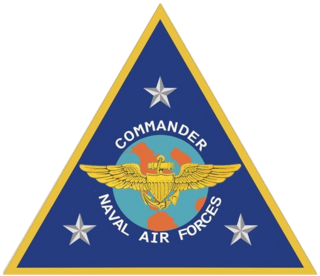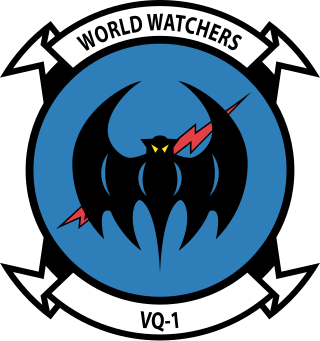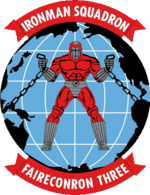
The Boeing E-6 Mercury is an airborne command post and communications relay based on the Boeing 707-300. The original E-6A manufactured by Boeing's defense division entered service with the United States Navy in July 1989, replacing the EC-130Q. This platform, now modified to the E-6B standard, conveys instructions from the National Command Authority to fleet ballistic missile submarines, a mission known as TACAMO.

TACAMO is a United States military system of survivable communications links designed to be used in nuclear warfare to maintain communications between the decision-makers and the triad of strategic nuclear weapon delivery systems. Its primary mission is serving as a signals relay, where it receives orders from a command plane such as Operation Looking Glass, and verifies and retransmits their Emergency Action Messages (EAMs) to US strategic forces. As it is a dedicated communications post, it features the ability to communicate on virtually every radio frequency band from very low frequency (VLF) up through super high frequency (SHF) using a variety of modulations, encryptions and networks, minimizing the likelihood an emergency message will be jammed by an enemy. This airborne communications capability largely replaced the land-based extremely low frequency (ELF) broadcast sites which became vulnerable to nuclear strike.

The Lockheed Martin EC-130 series comprises several slightly different versions of the Lockheed C-130 Hercules that have been and continue to be operated by the U.S. Air Force and, until the 1990s, the U.S. Navy.

The Lockheed EC-121 Warning Star was an American airborne early warning and control radar surveillance aircraft operational in the 1950s in both the United States Navy (USN) and United States Air Force (USAF).
Doomsday plane is an unofficial denomination of a class of aircraft which is used as an airborne command post in an event of nuclear war, disaster or other large scale conflict that threatens key military and government infrastructure.

Training Squadron EIGHT SIX (VT-86), also known as the "Sabrehawks," is a United States Navy advanced jet training squadron based at the Naval Air Station Pensacola, Florida. Training Squadron 86 is a tenant command of Training Air Wing 6. They are a training squadron flying the T-45C Goshawk. Their tailcode is F and their radio callsign is ROKT.

Margaret DeLuca "Peg" Klein is a former United States Navy officer who held the rank of rear admiral at the time of her retirement in March 2017. She currently serves as the dean of the College of Leadership and Ethics at the Naval War College.

Looking Glass is the historic code name for an airborne command and control center operated by the United States. In more recent years it has been more officially referred to as the ABNCP. It provides command and control of U.S. nuclear forces in the event that ground-based command centers have been destroyed or otherwise rendered inoperable. In such an event, the general officer aboard the Looking Glass serves as the Airborne Emergency Action Officer (AEAO) and by law assumes the authority of the National Command Authority and could command execution of nuclear attacks. The AEAO is supported by a battle staff of approximately 20 people, with another dozen responsible for the operation of the aircraft systems. The name Looking Glass, which is another name for a mirror, was chosen for the Airborne Command Post because the mission operates in parallel with the underground command post at Offutt Air Force Base.

VX-20, Air Test and Evaluation Squadron Twenty, is a United States Navy air test and evaluation squadron based at Naval Air Station Patuxent River, Maryland.

The Airborne Launch Control System (ALCS) provides a survivable launch capability for the United States Air Force's LGM-30G Minuteman III intercontinental ballistic missile (ICBM) force. The ALCS is operated by airborne missileers from Air Force Global Strike Command's (AFGSC) 625th Strategic Operations Squadron (STOS) and United States Strategic Command (USSTRATCOM). The system is located on board the United States Navy's E-6B Mercury, which serves as USSTRATCOM's "Looking Glass" Airborne Command Post (ABNCP). The ALCS crew is integrated into the ABNCP battle staff and is on alert around the clock.

Patrol Squadron Four (VP-4) is a U.S. Navy land-based patrol squadron based at the Naval Air Station Whidbey Island, Oak Harbor, Washington, which is tasked to undertake maritime patrol, anti-submarine warfare (ASW), and intelligence, surveillance and reconnaissance (ISR) missions flying the Boeing P-8 Poseidon.

The Commander, Naval Air Forces is the aviation Type Commander (TYCOM) for all United States Navy naval aviation units. Type Commanders are in Administrative Control (ADCON), and in some cases Operational Control (OPCON) of certain types of assets assigned to the Pacific and Atlantic Fleets. AIRFOR is responsible for the materiel readiness, administration, training, and inspection of units/squadrons under their command, and for providing operationally ready air squadrons and aircraft carriers to the fleet.

Robin Rumble Braun is a retired vice admiral of the United States Navy. Her last assignment was as Chief of Navy Reserve and Commander, Navy Reserve Force. She assumed that assignment on 13 August 2012. She was the first female commander of the United States Navy Reserve, and the first woman to lead any Reserve component of the United States military. Prior to her last assignment, Braun served as Deputy Director, European Plans and Operations Center, ECJ-3 United States European Command.

Fleet Air Reconnaissance Squadron 1 (VQ-1) is an aviation unit of the United States Navy established on 1 June 1955. Its role is aerial reconnaissance and signals intelligence. The squadron is nicknamed the "World Watchers" and is based at NAS Whidbey Island, flying Lockheed EP-3E Aries II aircraft.

Patrol Squadron 30 (VP-30) is a maritime patrol squadron of the United States Navy, established on 30 June 1960. It is based at Naval Air Station Jacksonville, Florida.

Strategic Communications Wing 1 is a nuclear command and control wing of the United States Navy. Its TACAMO mission provides airborne communications links to nuclear missile units of United States Strategic Command. It is located at Tinker Air Force Base, Oklahoma.

Fleet Air Reconnaissance Squadron VQ-2, also known as "Batmen" and later "Sandeman," was an air reconnaissance squadron of the United States Navy, established on 1 September 1955 and based at NAS Whidbey Island, previously at NAVSTA Rota, Spain, flying both Douglas EA-3B Skywarrior and Lockheed EP-3E Aries aircraft until 1991 and then strictly EP-3E aircraft until 2012. The squadron was disestablished on 22 May 2012.

Fleet Air Reconnaissance Squadron 4 (VQ-4), nicknamed the Shadows, is a naval aviation squadron of the United States Navy based at Tinker Air Force Base, Oklahoma. The squadron flies the Boeing E-6B Mercury airborne command post and communications relay aircraft. It is part of the U.S. Navy's TACAMO community, whose mission is to enable the President of the United States and the Secretary of Defense to directly communicate with U.S. submarines, bombers, and missile silos during a nuclear war.
The Lockheed E-XX is a planned United States Navy aircraft based on the EC-130J and intended to replace the Boeing E-6 Mercury in the TACAMO role, communicating with US nuclear ballistic missile submarines. The current E-6 aircraft were built in the late 1980s, and while they are expected to fly into the 2030s, the underlying platform is aging and support costs are increasing. Because of this, in 2020, the Navy began a program to develop a new platform. This program will take several years to complete, and the E-6 will continue to fulfill the role in the meantime.


















